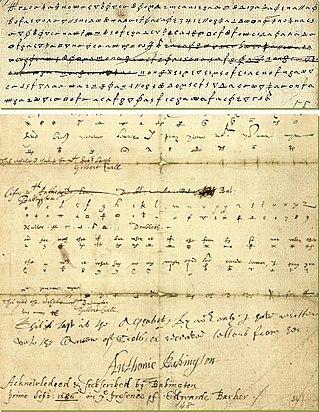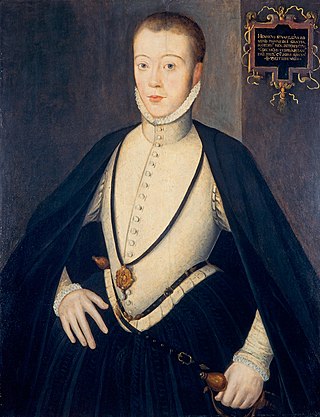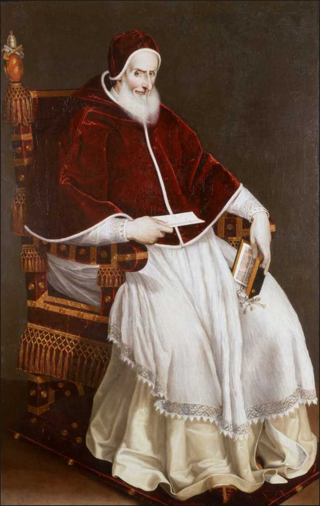Related Research Articles

Elizabeth I was Queen of England and Ireland from 17 November 1558 until her death in 1603. She was the last monarch of the House of Tudor.

Mary, Queen of Scots, also known as Mary Stuart or Mary I of Scotland, was Queen of Scotland from 14 December 1542 until her forced abdication in 1567.

The Babington Plot was a plan in 1586 to assassinate Queen Elizabeth I, a Protestant, and put Mary, Queen of Scots, her Catholic cousin, on the English throne. It led to Mary's execution, a result of a letter sent by Mary in which she consented to the assassination of Elizabeth.

Henry Stuart, Lord Darnley, was the second husband of Mary, Queen of Scots, and the father of James VI of Scotland and I of England. Through his parents, he had claims to both the Scottish and English thrones, and from his marriage in 1565 he was king consort of Scotland. Less than a year after the birth of his son, Darnley was murdered at Kirk o' Field in 1567. Many contemporary narratives describing his life and death refer to him as simply Lord Darnley, his title as heir apparent to the Earldom of Lennox.

Regnans in Excelsis is a papal bull that Pope Pius V issued on 25 February 1570. It excommunicated Queen Elizabeth I of England, referring to her as "the pretended Queen of England and the servant of crime", declared her a heretic, and released her subjects from allegiance to her, even those who had "sworn oaths to her", and excommunicated any who obeyed her orders: "We charge and command all and singular the nobles, subjects, peoples and others afore said that they do not dare obey her orders, mandates and laws. Those who shall act to the contrary we include in the like sentence of excommunication."

The Ridolfi plot was a Catholic plot in 1571 to overthrow Queen Elizabeth I of England and replace her with Mary, Queen of Scots. The plot was hatched and planned by Roberto Ridolfi, an international banker who was able to travel between Brussels, Rome and Madrid to gather support without attracting too much suspicion.

Mary, Queen of Scots is a 1971 biographical film based on the life of Mary Stuart, Queen of Scotland, written by John Hale and directed by Charles Jarrott. The cast was led by Vanessa Redgrave as the title character and Glenda Jackson as Elizabeth I. Jackson had previously played the part of Elizabeth in the BBC TV drama Elizabeth R, screened in February and March 1971, the first episode of which was also written by Hale.
Chidiock Tichborne, erroneously referred to as Charles, was an English conspirator and poet.

Elizabeth: The Golden Age is a 2007 biographical historical drama film directed by Shekhar Kapur and produced by Universal Pictures and Working Title Films. It stars Cate Blanchett in the title role and is a loose but fact-based portrayal of events during the latter part of the reign of Elizabeth I, forming a sequel to Kapur's 1998 film Elizabeth. The film co-stars Geoffrey Rush, Clive Owen, Jordi Mollà, Abbie Cornish, and Samantha Morton. The screenplay was written by William Nicholson and Michael Hirst, and the music score was composed by Craig Armstrong and A. R. Rahman. Guy Hendrix Dyas was the film's production designer and co-visual effects supervisor, and the costumes were created by Alexandra Byrne. The film was shot at Shepperton Studios and various locations around the United Kingdom.

Anthony Babington was an English gentleman convicted of plotting the assassination of Elizabeth I of England and conspiring with the imprisoned Mary, Queen of Scots, for which he was hanged, drawn and quartered. The "Babington Plot" and Mary's involvement in it were the basis of the treason charges against her which led to her execution. He was a member of the Babington family.
John Ballard was an English priest executed for being involved in an attempt to assassinate Queen Elizabeth I of England in the Babington Plot.
The 1583 Throckmorton Plot was one of a series of attempts by English Roman Catholics to depose Elizabeth I of England and replace her with Mary, Queen of Scots, then held under house arrest in England. The alleged objective was to facilitate a Spanish invasion of England, assassinate Elizabeth, and put Mary on the English throne.
Gilbert Gifford was a double agent who worked for Sir Francis Walsingham and played a role in the uncovering of the Babington Plot. Shortly before his death in Paris, he was ordained as a Catholic priest in Rheims. His true allegiances, whether to Queen Elizabeth I or to Mary, Queen of Scots, and the Catholic cause – are unclear.

Charles Paget was a Roman Catholic conspirator, involved in the Babington Plot to assassinate Queen Elizabeth I of England.
Thomas Morgan of Llantarnam (1546–1606), of the Welsh Morgan of Monmouthshire, was a confidant and spy for Mary, Queen of Scots, and was involved in the Babington plot to kill Queen Elizabeth I of England. In his youth, Thomas, a staunch Catholic, worked as Secretary of the Archbishop of York until 1568, and then for Lord Shrewsbury who had Mary under his care at this time. Morgan's Catholic leanings soon brought him into the confidence of the Scottish queen and Mary enlisted Morgan as her secretary and go-between for the period extending between 1569 -1572 which coincided with a series of important conspiracies against Elizabeth. Morgan was imprisoned for 3 years in the Tower of London before exiling himself to France.
Christopher Hodgson was a Catholic priest who played a minor role in the Babington Plot. The plot was a failure and eighteen of the main conspirators were hung, drawn, and quartered in London in 1586. Hodgson was a committed Roman Catholic, in defiance of the Elizabethan authorities. But he clashed with the Jesuits and like several other English Catholics he opposed a Spanish invasion. He was a close friend of Gilbert Gifford and an acquaintance of Charles Neville, 6th Earl of Westmorland in exile.
Henry Donn was one of the conspirators executed for his involvement in the Babington Plot, a plot in 1586 to assassinate Queen Elizabeth, a Protestant, and put Mary, Queen of Scots, a Catholic, on the English throne.
Events from the year 1586 in the Kingdom of Scotland.

A Column of Fire is a 2017 novel by British author Ken Follett, first published on 12 September 2017. It is the third book in the Kingsbridge Series, and serves as a sequel to 1989's The Pillars of the Earth and 2007's World Without End.
John Savage was an English Catholic, who was one of the conspirators executed for his involvement in the Babington Plot, a plot in 1586 to assassinate Queen Elizabeth, a Protestant, and put Mary, Queen of Scots, a Catholic, on the English throne. A former soldier, Savage was to have been the man who would personally assassinate Elizabeth.
References
- ↑ "Babington plot". www.tudorplace.com.ar. Retrieved 27 January 2024.